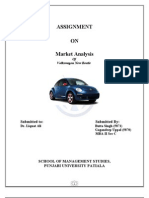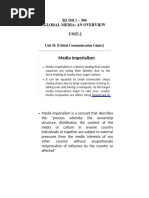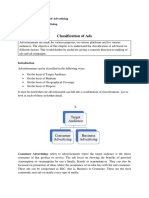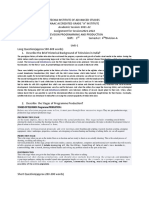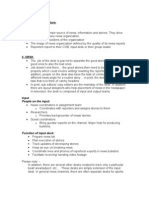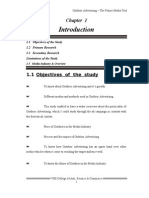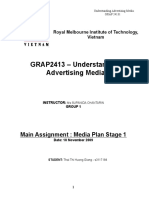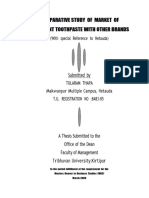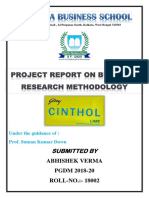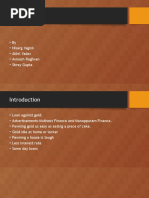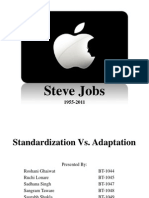Media Research Final
Media Research Final
Uploaded by
Lisa MendesCopyright:
Available Formats
Media Research Final
Media Research Final
Uploaded by
Lisa MendesCopyright
Available Formats
Share this document
Did you find this document useful?
Is this content inappropriate?
Copyright:
Available Formats
Media Research Final
Media Research Final
Uploaded by
Lisa MendesCopyright:
Available Formats
Table of contents
CONTENTS
PAGE NO.
Introduction: MEDIA RESEARCH Current trends of media in India
1 6
Significance of media research to marketers
13
Objectives
19
Research methodology: 1)consumer behavior 2) media research company(TAM) Data analysis: 1)consumer behavior 2) media research company(TAM) Findings and interpretation: 1)consumer behavior 2) media research company(TAM) Bibliography
19
20
24
27
Annexure:1 (consumer questionnaire)
28
Annexurure:2(media research company questionnaire)
30
Media Research
INTRODUCTION: MEDIA RESEARCH
The origin of media research:
Mass media has become a research issue during the 1930s and 1940s. This has imprinted it with an early concern with psychological effects that individuals cannot control or avoid. Hitlers purported hypnotic power to control the masses through radio broadcasts was the most vivid image of such effects. Early research has been heavily influenced by these concerns and this remains an important theme of cultural and sociological meditation. Just as journalism media studies are often classified as social sciences, methods are often drawn from social sciences such as anthropology, sociology and psychology
1|Page
Media Research
Introduction: Media Research:
When hearing the term mass media research for the first time, many people ask two questions: 1) What are the mass media? 2) What types of things do mass media researchers investigate? Lets address these questions before getting into the specifics of research What are the mass media? The term mass media refers of any form of communication that simultaneously reaches a large number of people, included but not limited to radio, TV, newspapers, magazines, internet, billboards, films, recording and books. What type of things do mass media researchers investigate here are a few examples What type of format should a radio station adopt? What type of hosts do listeners want on a radio station morning show? What is the most famous and least favorite local TV news programme? How effective is advertising on TV, Radio, and in all types of print media? What adds do readers see more often in a local news paper Which websites are more popular and why? What types of internet pop up ads are successful? What are the elements of a successful magazine cover page?
The types of questions investigated in mass media research are virtually unlimited. However, even this short list demonstrates why it is necessary to understand mass media research and anyone who works in the media (or plans to) will be exposed to or will be involved in research.
2|Page
Media Research
What is research? Regardless of how the word research is used it will essentially means the same thing: an attempt to discover something. We all do this every day. The research can be very informal with only a few plans of steps, or it can be very formal where a research follows defined and exacting procedures. There are three basic steps to success in business (and for that matter, very fact of life) 1) Find out what people want? (Customers, audiences, readers, family) 2) Give them what they want 3) Tell them that you gave it to them. Failures are virtually impossible if you follow their three step philosophy. How can you fail when you give people what they ask for? The way to find out what people wants is through research. It is because of research in media, we have been able to grow media as an industry. Research has made a significant development in the field of media. It helps us get new information. It has helped to use new technology for its development. It is only due to research, we get valid knowledge that we can prove and trust it without any hesitation. Research is not limited only to decision making situation. It is also widely used in theoretical areas to attempt to describe the media, to analyze media effects on consumers, to understand audience behaviour, and so on. Mass media research, accordingly, deals with the production of programs and the consumption of the audience. For both perspectives, research topics are justified, data sources are introduced, and recommendation for the research infrastructure are given.
3|Page
Media Research
Significance of media research We need to know what is mean by research. Research can be defined to be search for knowledge or any systematic investigation to establish facts. The primary purpose for applied research (as opposed to basic research) is discovering, interpreting, and the development of methods and systems for the advancement of human knowledge on a wide variety of scientific matters of our world and the universe. Research can use the scientific method; scientific research relies on the application of the scientific method, a harnessing of curiosity. This research provides scientific information and theories for the explanation of the nature and the properties of the world around us. It makes practical applications possible. Scientific research is funded by public authorities, by charitable organisations and by private groups, including many company Research in mass media is used to verify or refute gut feelings or intuition for decision makers. Although common sense is sometimes accurate, media decision makers need additional objective information to evaluate problems, especially when they make decisions that involve large sums of money. Mass media research is not limited only to decision-making situations. It is also widely used in theoretical areas to attempt to describe the media, to analyze media effects on consumers, to understand audience behaviour and so on. Everyday there are references in the media to audience surveys, public opinion polls, growth projections or status reports of one medium or another.
4|Page
Media Research
and/or marketing agency, its a good rule of thumb to confirm that their service promise is backed by appropriate media, research and management software and services. Its important to ask if this potential business partner has certain capabilities in house and specific procedures in place
Media research companies: When considering an advertising
TNS TNS is the world's largest Custom Market Research specialists. They provide quality marketing information delivered by Global Industry Sector expert consultants, innovative Market Research Expertise across the product life-cycle, in 80 countries. TNS is the leading market research agency in most European countries. In the US, TNS is the World's largest custom market research company. TNS has offices in more than 80 countries across Africa, Americas, Asia Pacific, Europe and the Middle East. Established in early 2004, Impact Research and Measurement Are a pioneer and a leader in offering web based media monitoring & measurement services in India. Today they help close to 200 leading Indian and transnational companies achieve their communication goals by empowering them with in-depth secondary market research, media intelligence, media analytics, and competitive benchmarking. The Nielsen Company Are a global information and media company with leading market positions in marketing and consumer information, television and other media measurement, online intelligence, mobile measurement, trade shows and business publications (Billboard, The Hollywood Reporter, Adweek). Is the global leader in multinational media research and analysis. Through a network of affiliates, coverage is extended to more than 70 countries; representing 85% of the world's advertising spend. The GfK Group Is one of the largest market research companies in the world. The Group has a staff complement of 10,000+ employees working in 150 operating companies covering more than 100 countries of the world who deliver the knowledge on markets and sectors which our clients need for their decisions.
5|Page
Media Research
CURRENT TRENDS OF MEDIA IN INDIA!
ELECTRONIC MEDIA! Electronic media are media that use electronics or electromechanical energy for the end-user (audience) to access the content. This is in contrast to static media (mainly print media), which today are most often created electronically, but don't require electronics to be accessed by the end-user in the printed form. The primary electronic media sources familiar to the general public are better known as video recordings, audio recordings, multimedia presentations, slide presentations, CD-ROM and online content. Most new media are in the form of digital media. However, electronic media may be in either analog or digital format. Although the term is usually associated with content recorded on a storage medium, recordings are not required for live broadcasting and online networking. Any equipment used in the electronic communication process (e.g. television, radio, telephone, desktop computer, game console, handheld device) may also be considered electronic media! There are basically 3 types of electronic Media in India. They are: 1) Television 2) Radio 3) Internet
TELEVISION! Terrestrial television in India started with the experimental telecast starting in Delhi on 15 September 1959 with a small transmitter and a makeshift studio. The regular daily transmission started in 1965 as a part of All India Radio. The television service was extended to Bombay (now Mumbai) and Amritsar in 1972. Up until 1975, only seven Indian cities had a television service and Doordarshan remained the sole provider of television in India. Television services were separated from radio in 1976. National telecasts were introduced in 1982. In the same year, colour TV was introduced in the Indian market. Indian small screen programming started off in the early 1980s. At that time there was only one national channel Doordarshan, which was government owned. As of 2010, over 500 TV Satellite television channels are broadcasted in India. This includes channels from the state-owned Doordarshan, News
6|Page
Media Research
Corporation owned STAR TV, Sony owned Sony Entertainment Television, Zee TV, Sun Network and Asianet. Direct To Home service is provided by Airtel Digital Tv, BIG TV owned by Reliance, DD Direct Plus, DishTV, Sun Direct DTH, Tata Sky and Videocon D2H. DishTV was the first one to come up in Indian Market, others came only years later. With 1,400 television stations as of 2009, the country ranks 4th in the list of countries by number of television broadcast stations. RADIO Radio broadcasting is an audio broadcasting service, broadcast through the air as radio waves from a transmitter to an radio antenna and, thus, to a receiver. Radio broadcasting was initiated in 1927 but became state responsibility only in 1930. In 1937 it was given the name All India Radio and since 1957 it has been called Akashvani. There are 153AM broadcasting stations and, 91 FM stations in India! On November 16, 2006, the Government of India released the community radio policy which allowed agricultural centers, educational institutions and civil society organizations to apply for community based FM broadcasting license. Community Radio is allowed 100 Watt Effective Radiated Power (ERP) with a maximum tower height of 30 meters. The license is valid for five years and one organization can only get one license, which is non-transferable and to be used for community development purposes. INTERNET India has the world's third largest Internet users with over 100 million users (of whom 40 million use the Internet via mobile phones) as of December 2010. Internet penetration in India is one of the lowest in the world which is 8.4% of the population, compared to other nations like United States, Japan or South Korea where Internet penetration is significantly higher than in India. Broadband: The number of broadband connections in India has seen a continuous growth since the beginning of 2006. As of June 2011, total broadband Internet users in the country have reached 12.32 million constituting 0.9% of the population. India ranks one of the lowest providers of broadband speed as compared countries such as Japan, South Korea and France. And according to research, there are currently, 86517 Internet Service Providers in India!
7|Page
Media Research
OUTDOOR ADVERSTING Outdoor advertising is no more restricted to billboards. As the Indian consumer is bombarded with 1,00,000 advertisements a day on more than 250 channels, outdoor advertising has shown promise to break the clutter of advertising on traditional mediums.
8|Page
Media Research
TRANSIT MEDIA Transit media is a form of out-ofhome advertising that uses vehicular platforms to establish a mobile brand presence. Typically, transit media campaigns are employed in denser urban environments to maximize brand exposure to both pedestrian and onroad traffic. The medium has traditionally been limited to featured advertisements on buses and trams, but in recent years has extended to various sub-categories, such as dedicated car, van or truck advertising. Recently advertising on the exterior of buses has pushed conventional boundaries of static media with the introduction of LED Displays. This allows the site owner to generate higher revenue as they can rotate ads and also schedule ads by GPS Location allowing advertisers to target their audience more effectively. Transit Media stands a good chance of an average of 18 hours of exposure every day. In other media, the life of your advertisement is much shorter lived. More than 1, 00,000 people are exposed to the ad every day which compares favorably with the sky high rates of other media.It is very tough to bring consumers to your ads transit media takes your ad to the consumers!
BILLBOARDS: It is the invention of lithography in 18th century that gave birth to posters and later modern billboards. Modern billboards are quite distinct from billboards of the past because: (a) modern science is used in crafting effective and influential images and messages for selling products, ideas, and people (politicians, judges, clergy, gurus, and even prophets), (b) modern technology is used in designing images that could not have been produced before, and (c) they are governed by ordinances affecting their size, lighting, and places where they are installed.
9|Page
Media Research
Also, modern billboards have moved away from the use of purely text messages to images and shorter, memorable, and catchy phrases that viewers can carry with them away. For a passing driver a picture can be absorbed a lot faster that 3 sentences with 15 words! A large panel that carries outdoor advertising is usually found alongside of highways. A billboard or hoarding is a large outdoor signboard usually wooden found in places with high traffic such as cities, roads, motorways and highways. Billboards show large advertisements aimed at passing pedestrians and drivers. The vast majority of billboards are rented to advertisers rather than owned by them. Some billboards consume some more space than what is allotted. Undoubtedly it comes at an extra cost but the end look is extremely attractive. A billboard is viewed mostly by those who are driving or walking by. Thus the hoarding has only a few seconds to make the product noticeable. Hence very few words are used on a billboard or hoarding. Placement of your hoarding too is very important. As it gives maximum coverage to every passerby your target audience is lost. Hence you have to find which best place can give you maximum reach to your target audience besides the other classes. With modern technology digital billboards and tri-faced billboards are moving the market. Digital billboards allow long messages to run continuously across the screen. In Europe innovations are to make digital hoardings interactive. Tri-faced billboards are triangular panels that can display three ads consecutively. Vinyl strips are cut and placed on these panels to make one ad display at one time. Thus when the panels rotate and pause you can see three different ads. Their rotating movement attracts the passing crowd.
PRINT MEDIA
Printing is a process for reproducing text and image, typically with ink on paper using a printing press. It is often carried out as a large-scale industrial process, and is an essential part of publishing and transaction printing. Print media is one of the oldest and basic forms of mass communication. It includes newspapers, weeklies, magazines, monthlies and other forms of printed journals. Printing technology came to India in 1556. The first book printed in India was in Portuguese language in Old Goa. Even after the advent of electronic media, the print media has not lost its charm or relevance. Print media has the advantage of making a longer impact on the minds of the reader, with more indepth reporting and analysis. There are basically 2 types of Print Media in India. They are: 1) Newspapers 2) Magazine
10 | P a g e
Media Research
NEWSPAPERS The first newspaper in India was produced in Calcutta. On January 29, 1780 James Augustus Hickey launched the Bengal Gazette. It has another title Calcutta Advertiser. It was popularly known as Hickeys Gazette. The first issue of the paper had two pages and later it was increased to four pages. Its size was 35 cms x 24 cms. The British East India Company did not consider freedom of the press as good for society. They tried to suppress publication of newspapers. So, they confiscated his paper and press in 1782 and stopped its publication. Hickey was asked to leave the country. He was sent back to England. In 1780, the second newspaper was launched from Calcutta The Indian Gazette. The Calcutta Gazette which started publication in 1784 and the Bengal Journal which was launched in 1785 were the third and fourth newspapers to come out from Calcutta. All these four earlier papers were published in the English language. Slowly newspapers started coming out from other parts of the country also. The Madras Courier (1785) and Madras Gazette (1795) were started from Madras. From Mumbai, the Mumbai Herald was launched in 1789. The first language newspaper in India was started in Kannada language, the Kannada Samachar. But the publishers of this paper were not Indians, but foreign missionaries. The first Indian language newspaper published by an Indian was also launched from Calcutta, The Bengali Gazette by Gangadhar Bhattacharjee in 1816. The Gujarati daily Mumbai Samachar published from Mumbai is the oldest existing newspaper not only in India but also in Asia. It was established in 1822. Today, due to the development of modern technology and the multiple languages spoken in India newspapers are printed in various languages like Hindi, Marathi, Malayalam, Kannada, Tamil, Telugu, Oriya, Assamese, Urdu and Bengal. The 2010 Indian Readership Survey findings show that the largest read local language newspapers to be Dainik Jagran (with 16.0 million readers) and Dainik Bhaskar (with 13.5 million readers), both published in Hindi. The Times of India is the most widely read English language newspaper (7.3 million), followed by Hindustan Times (3.5 million), The Hindu (2.1 million). The New Indian Express is another widely-read English language newspaper (1.8 million}. Malayala Manorama newspaper which is published in Malayalam from Kerala currently has a readership of over 9.9 million (with a circulation base of over 1.8 million copies) has the most circulation in regional languages.
11 | P a g e
Media Research
MAGAZINES Magazines are publications; generally published on a regular schedule, containing a variety of articles. Magazines for a long time have been a good source of information and entertainment. Magazines cover topics ranging from fashion, sports, life style and relationships. Magazines are more popular in the urbanized areas of India than the rural areas. Today magazines in India are available even in regional languages. Grishobha is a womens magazine that is published in Hindi and its first language edition was published in 1989. Magazines are designed to attract audiences of all age groups and genders are called general purpose magazines. But some magazines target only a particular audience e.g. some magazines try to target women audience like Femina, which is a joint venture between BBC worldwide and The Times Group. It published its first edition in 1959. Business magazines contain information relating to the latest developments and trends in the world of business. Business today is a business magazine in publication since 1992. It has a current readership of 3380000 per issue. Filmfare is an English-language tabloid-sized magazine about Indian cinema. Published by The Times Group, India's largest media services conglomerate, in Mumbai (Bombay), it highlights the doings of the Bollywood film scene. The most popular entertainment magazine in India, it is read by the overseas Indian community worldwide.
12 | P a g e
Media Research
SIGNIFICANCE OF MEDIA RESEARCH FOR MARKETERS:
MARKETING
Media Research Product Research Consumer Research Sales Research Corporate Research
Advertising Effectiveness studies Readership surveys Motivation Surveys
Competitive product selling Product testing Concept testing Positional testing Packaging research Brand profile
Panel research Dairy research Consumer profile Behaviour prospecting
Sales analysis Tests marketing Distribution Chanel Studies Market analysis Market potential Sales of research
Trend analysis Forecasing Pricing Studies Product mix studies Environmental analysis Consumer studies Corporate image
The definition of marketing research
The Chartered Institute of Marketing define marketing as 'The management process responsible for identifying, anticipating and satisfying customer requirements profitably' Marketing objectives, goals and targets have to be monitored and met, competitor strategies analyzed, anticipated and exceeded. Through effective use of market and marketing research an organization should be able to identify the needs and wants of the customer and try to delivers benefits that will enhance or add to the customers lifestyle, while at the same time ensuring that the satisfaction of these needs results in a healthy turnover for the organization.
13 | P a g e
Media Research
Marketing research is a comprehensive term with a very wide scope. Marketing research is a research of the market place- its characteristics, size, potential etc. Both qualitative and quantitative research is necessary in advertising professionals Market research encompasses broadly all the areas viz product research, promotion research, sales research and corporate sales
Media Objectives How is a media plan developed? Media planning is a four-step process which consists of 1) setting media objectives in light of marketing and advertising objectives, 2) developing a media strategy for implementing media objectives, 3) designing media tactics for realizing media strategy, and 4) proposing procedures for evaluating the effectiveness of the media plan. Let's take a look at the planning process through an example: P&G's launch of the Gillette Fusion shaving system for men in early 2006. First, P&G's media objectives called for a $200 million media blitz to reach men in the U.S. Second, P&G's strategy included a mix of national media to introduce the brands. For example, television advertising, such as a $5 million Super Bowl ad campaign, portrayed Fusion as an advanced technology found in a secret government UFO lab. The TV ads also established the brand's signature orange and blue color scheme. In store aisles, 180,000 display units promoted Fusion, using the brand's colors to catch consumers' attention. "We're trying to put the product wherever men shop," said Pauline Munroe, marketing director for blades and razors in P&G's Gillette business unit. Third, P&G's media tactics -- such as a Father's Day sweepstakes, an episode of NBC's The Apprentice in which the show's teams competed to promote the razor, and sponsorship of competitive surfing -- helped the company reach men of all ages. "Fusion will get so much attention that it will drive a lot of men to try these grooming products," said Gary Stibel of New England Consulting Group. Finally, P&G used sales and market share targets to assess the effectiveness of the media plan. P&G expects sales of Fusion to reach $1 billion in sales by year three. P&G knows that the brand has already achieved 25% market share in the U.S. Thus, although $200 million seems like a lot to spend on advertising a new product, it represents a sound financial investment toward the tremendous future profit that P&G will gain from the new shaving system.
14 | P a g e
Media Research
Now, let's take a deeper look into the media planning process. Media planning, such as planning the marketing communications for the launch of the Fusion new shaving system, starts with setting media objectives. Media objectives usually consist of two key components: target audience and communication goals. The target audience component of the media objectives defines who is the intended target of the campaign. For example, P&G's target audience objective for its Fusion shaving system was men 18-40 years old. The communications goals component of the media objectives defines how many of the audience the campaign intends to reach and how many times it will reach them. In short, media objectives are a series of statements that specify what exactly the media plan intends to accomplish. The objectives represent the most important goals of brand message dissemination, and they are the concrete steps to accomplish marketing objectives. The next two sections provide details on target audience and communication goals. You'll learn about sources of data to use to identify your target audience. You'll also learn how to quantify communication plans. Evaluating Media Plan Effectiveness Accountability is increasingly important in media planning, as more advertisers expect to see returns on their investments in advertising. Because media spending usually accounts for 80 percent or more of the budget for typical advertising campaigns, the effectiveness of media plans is of particular importance. As a result, media planners often make measures of the effectiveness of a media plan an integral part of the media plan. Although sales results are the ultimate measure of the effectiveness of an advertising campaign, the sales result is affected by many factors, such as price, distribution and competition, which are often out of the scope of the advertising campaign.[34] It is important, therefore, to identify what measures are most relevant to the effectiveness of media planning and buying. We will examine the topic of measurement in more detail in chapters 21 and 22, but here is an introduction to measurement that is specific to media plans. What to Measure Because of the hierarchical nature of the media effects, the effectiveness of media planning should be measured with multiple indictors. The first measure is the actual execution of scheduled media placements. Did the ads appear in the media vehicles in agreed-upon terms? Media buyers look at "tear-sheets" -copies of the ads as they have appeared in print media -- for verification purposes. For electronic media, media buyers examine the ratings of the programs in which commercials were inserted to make sure the programs delivered the promised ratings. If the actual program ratings are significantly
15 | P a g e
Media Research
lower than what the advertiser paid for, the media usually "make good" for the difference in ratings by running additional commercials without charge. The most direct measure of the effectiveness of media planning is the media vehicle exposure. Media planners ask: How many of the target audience were exposed to the media vehicles and to ads in those vehicles during a given period of time? This question is related to the communication goals in the media objectives. If the measured level of exposure is near to or exceeds the planned reach and frequency, then the media plan is considered to be effective. Several additional measures can be made of the target audience, such as: Brand awareness -- how many of the target audience are aware of the advertised brand? Comprehension -- does the target audience understand the advertised brand? Is there any miscomprehension? Conviction -- is the target audience convinced by ads? How do they like the advertised brands? Action -- how many of the target audience have purchased the advertised brand as a result of the media campaign? The measured results of brand awareness, comprehension, conviction and action are often a function of both advertising creative and media planning. Even effective media planning may not generate anticipated cognitive, affective and conative responses if the ads are poorly created and not appealing to the target audience. On the other hand, ineffective media planning may be disguised when the ads are highly creative and brilliant. Thus, these measures should be reviewed by both creative directors and media planners to make accurate assessments of the effectiveness of the media plan. How to Measure The measurement of the effectiveness of a media plan can be conducted by the advertising agency or by independent research services, using methods such as surveys, feedback, tracking, and observation. Each method has its strengths and weaknesses. For example, surveys can be conducted among a sampling of the target audience in the different periods of a media campaign, such as in the beginning, the middle and the end of the campaign. Surveys can ask questions about the target audience's media behavior, advertising recall, brand attitudes and actual purchase. Radiowatch, for instance, conducts monthly surveys on advertising recall of radio commercials in England. Radiowatch surveys 1000 adults age 16-64 and asks them which radio commercials they remember hearing. In the April 2006 survey, the most16 | P a g e
Media Research
recalled ad was for T-Mobile, with 46% of respondents recalling the ad. An ad for McDonald's had 36% recall, while the ad for Peugeot received 18%. Besides surveys, feedback can be collected to measure the media and ad exposure of the target audience. Feedback devices such as reply cards, toll-free numbers, coupons and Web addresses can be provided in ads so that tallies of the responses or redemptions can be made to estimate the impact of advertising media. Advertisers often use a different code in direct response ads to identify different media vehicles. For example, in the April 3 2006 issue of BusinessWeek, the reply card for subscribing to the magazine had a code of JS6D1, whereas the reply card bound into the May 29, 2006 issue of the magazine had a code of JS6E2. Similarly, when the Garden of Eatin' gives coupons for its tortilla chips, the UPC code on the coupon indicates which media vehicle the coupon was in, such as whether the coupon came from the 2006 Bolder Boulder promotional calendar or from the Organic and Natural Experience (ONE) 2006 Tour book of coupons. In short, by reviewing the different codes recorded, media buyers can assess the response rate of each media vehicle. As you can see from the Radiowatch and Garden of Eatin' examples, one advantage of surveys over feedback devices is that surveys reach people who have taken no action on the product, whereas feedback devices require the consumer to mail back, click or call a toll-free number. In this way, surveys can help media buyers evaluate the effectiveness of an ad in relation to other ads, whereas feedback devices help them evaluate the effectiveness of one media vehicle over another. Tracking is measurement method that media buyers use to track the effectiveness of online ads. When a user visits a Web site or clicks on a banner ad, Web servers automatically log that action in real time. The logs of these visits and actions are very useful for media buyers, because the buyers can use them to estimate the actual interaction of audience members with the interactive media. For example, a banner ad may have a code for each Web site where the ad is placed. Media buyers can compare the click-through rates of the banner ad across all Web sites daily, to estimate the effectiveness of each Web site. Media buyers are making more use of the tracking method given the increasing use of interactive media. Finally, in the physical world, media buyers can use observation to collect audience reaction information at the points of purchase or during marketing events. For example, researchers can be stationed in grocery stores to observe how consumers react to in-store advertising or how they select an advertised brand in comparison of other brands. The advantage of observation is that it provides rich, detailed data on how consumers behave in real situations in
17 | P a g e
Media Research
response to the marketing communication. The downside is that direct observation is more costly to conduct and tabulate. This article described the media planning process, starting from establishing media objectives through to developing media strategies and tactics and finally evaluating the effectiveness of the media plan. You've learned how to identify your target audience; evaluate different media vehicles on the basis of reach, frequency and GRPs; make prudent media mix decisions using tools like BDI and CDI and scheduling concepts like continuity, flight and pulse scheduling; make sound budget decisions using tools like CPP and CPM; and, finally, evaluate the effectiveness of your media plan through surveys, feedback devices, tracking and observation. In the next four chapters, we'll delve more deeply into the different types of media ?print media, broadcast media, out-of-home media and interactive media ?to help you understand the ad formats, strengths/weakness and cost structures of each of these advertising media.
18 | P a g e
Media Research
OBJECTIVES
1. Consumer relationship with Media. 2. Workings of media research company. (TAM)
RESEARCH METHODOLOGY
Objective 1: In todays day and age there are a no. of media vehicles or media tools that companies/marketers use to disseminate their message to their consumers. We conducted a research to find out how consumers were influenced by different types of media and also the different dimensions that increases their inclination towards the particular Media tool. Research design that we used was descriptive-conclusive research, while the sampling was simple random sampling. We took are sample size as 50
Objective 2: To fulfill our objective to study the working of a media research company, we approached TAM MEDIA PVT. LTD.to give us a review on how they follow and practice it. We wanted to conduct a detailed study on what media tools the company measures, what according to them are the advantages and disadvantages of media research, how media research has been carried out by TAM, the significance of media research for marketers and the best form of media according to the company.
19 | P a g e
Media Research
ANALYSIS AND DATA Consumer behavior)
1) Do you think advertising influences you?
10%
yes no
90%
2) What media do you consider to be the most reliable source of information?
100 80 60 40 20 0 tv newspapers radio e-news 16.67 6.67 0 76.67
3) Are you aware of any media Research Company?
20% No yes 80%
20 | P a g e
Media Research
4) Select the following based on parameters given below? a) TELEVISION:
35 30 25 20 15 10 16 5 0 effectiveness reliability attractiveness deceptive informative 16 11 31 26
b) PRINT MEDIA:
60
50
40
30 49 20 29 10 11.5 5.25 0 effectiveness reliability attractiveness deceptive informative 5.25
21 | P a g e
Media Research
c) RADIO:
35 30 25 20 15 10 5 0 effectiveness 0 reliability 2.5 attractiveness deceptive informative 32.5 32.5 32.5
d) INTERNET:
50 45 40 35 30 25 20 15 10 5 0 effectiveness 0 reliability attractiveness 17.5 7.5 deceptive informative 27.5 47.5
22 | P a g e
Media Research
5) In your opinion what makes a good commercial?
graphic music celebrity endorsments 0% concept
20%
10%
70%
6) Do media influences you to make a buying decision?
20%
Yes No
80%
23 | P a g e
Media Research
FINDINGS AND INTERPRETATION:
1) CONSUMER RELATIONSHIP WITH MEDIA: According to our survey conducted we interpreted that advertising influences majority of the people We found out that information through NEWSPAPERS was most reliable followed by TV and RADIO whereas E-NEWS was found unreliable Majority of the people had no knowledge about any existence of media research companies and were not aware of the functions carried by them. While just a few were aware of the companies that conduct Media Research (TAM, NIELSEN, NRS) We asked people what appealed to them in a commercial. Majority of the people found the CONCEPT i.e. the storyline of advertisement more appealing where as GRAPHIC; MUSIC and CELEB ENDOURSMENT were given least preference. The few product commercials that most of our respondents remembered clearly were: a) FMCG product: Pantene, Dove, Garnier products b) Consumer durables: LG, Maruti ,Samsung People found T.V to be more attractive than informative. However, they even found it to be the most deceptive form of Media While for Print media people found it to be more informative and reliable, because they gain knowledge about the product via this media. When talking about Radio people found it to be effective, attractive as well as informative. People found the internet informative.
24 | P a g e
Media Research
FINDINGS AND INTERPRETATION: 2: TAM MEDIA RESEARCH : Importance of conducting MEDIA RESEARCH :
According to TAM- media research is an integral part for any advertiser or marketer to judge the popularity and effectiveness of the advertising medium. Media research also facilities planning and the media planner gets valuable information from the research.
Reasons to measure the effectiveness of a media vehicle:
Increasing efficiency in advertising was considered to be the main reason to measure the effectiveness of a media vehicle. Advertising efficiency--ratio of the cost of advertising to the number of targeted audiences reached.
Best tools for communicating an advertising message :
TV is the most effective medium to communicate and disseminate a message. Television brings the eye and the ear together and thus makes the experiences concrete, real and immediate.
TAM measures the viewership in case of TV, and the listenership in case of radio. Example :
Universe The Total/Actual number of people in a defined target audience Reach -Number of individuals from the universe who are exposed to the medium or vehicle -Reach is normally expressed in Percent terms Calculation of Reach Universe: 10 individuals. For a single episode of Chhoti Maa: if out of the above 10 people 6 saw atleast 1 minute of the programme then, Reach:6 out of 10 Therefore, reach = 60%
Media tools measured by TAM
25 | P a g e
Media Research
Sources of data collection
The data collected for media research are authentically the companies itself. TAM has its own processes through which the data is collected, evaluated and results are drawn. Primary data is collected for the purpose of media research and it uses a syndicated data base. Advantages: Helps in scientifically spending the money and enhances the effectiveness of the ad campaign.
Processes or tools used by TAM to gather data.
Advantages and disadvantages of conducting Media research
Disadvantages: People stop innovating and only believe in tested methods.
How do companies use the results while planning their strategies and campaigns?
Advertisers get accurate, reliable and authentic information regarding the viewership, readership and listenership of their advertising medium. Example: T.V-companies use the research results to see which channels and programs are watched by the Target audience and the information can be used to effectively plan their future strategies and campaigns. The reports guide and update the organizations information which is useful to them as well as others in the advertising field.
Significance of Media research to marketers
Media research helps marketers in planning and scientifically spending the money. It also helps marketers to decide the medium to effectively reach their target audience.
According to TAM media research
the most cost effective media is T.V. It is a versatile vehicle. Models, graphs, pictures, exhibits all can be introduced through the medium. It is so visually stimulating that one can make use of the same for a wide variety of purposes and gain it has a wider reach . The best form of communicating an advertising message: Out of the box thinking
26 | P a g e
Media Research
BIBLIOGRAPHY:
Websites:
1) http://en.wikipedia.org/wiki/Printing 2) http://download.nos.org/srsec335new/ch5.pdf 3) http://en.wikipedia.org/wiki/Category:Indian_magazines 4) http://www.tamindia.com/ 5) http://www.tnsglobal.com/ 6) http://www.impactmeasurement.co.in/ 7) http://in.nielsen.com/ 8) http://www.gfk.com/group/company/index.en.html 9) http://www.iranian.com/AliAkbarMahdi/2004/November/India3/index.html 10) http://advertising.indiabizclub.com/info/billboards 11) http://www.entrepreneur.com/tradejournals/article/112248758.h 12) http://devyanikoblog.blogspot.com/2009/09/significance-of-media-research.html 13) http://www.nordicom.gu.se/common/publ_pdf/264_herkman.pdf 14) http://allaboutoutdoor.com/Transit/Transitadvertise.aspx 15) http://www.simplesolutionsindia.com/why-transit-media.html 16) http://www.admedia.org/
Books:
1) 2) 3) 4) 5) Advertising and media research: SN dixit JP Ahuwaliya: media research methodology Mass communication and media studies: masscomedia : SA Chunawala Mass media research: an introduction: Roger D Wimmer Joseph.R.Dominick the origins of media research the effect paradigm: Sorin Adam Matei
27 | P a g e
Media Research
ANNEXURE 1:
Questionnaires for the Viewers/ Consumers
Name_______________
Age____
Gender M/F
1) Do you think advertising influences you? Yes No
2) What media do you consider to be the most reliable source of information? TV Newspaper Radio E-news
3) Are you aware of any media Research Companys? Yes No
If yes then name them_________________ 4) Select the following based on parameters given below? a) TELEVISION: o effectiveness o reliability o attractiveness o deceptive o informative b) PRINT MEDIA o effectiveness o reliability o attractiveness o deceptive o informative o
c) RADIO o effectiveness o reliability o attractiveness o deceptive o informative
28 | P a g e
Media Research
d) INTERNET o effectiveness o reliability o attractiveness o deceptive o informative
5) In your opinion what makes a good commercial? Graphic Music celebrity endorsements
concept
6) Name any two products commercials on TV you can remember clearly? c) FMCG product: ____________ d) Consumer durables:______________ 7) Do media influences you to make a buying decision? Yes No
29 | P a g e
Media Research
ANNEXURE: 2
Questionnaire for the media research company
Q1) Do you think it is important to conduct media research? YES NO
Q2) What are the reasons to measure the effectiveness of a media vehicle? o To avoid costly mistakes o Evaluate alternative strategies o Increasing efficiency of advertising o Media planning Q3) What are the best tools for communicating and advertising a message? TV Radio Internet Print Media Outdoor
Q4) What are the media tools your company measures ? TV Radio Print media
Q5) What data sources are typically used in media research by your company? TAM external sources any other
Q6) Name a few advantages and disadvantages of conducting media research? Advantages______________________________________________ Disadvantages____________________________________________
Q7) What processes or tools does your company use to gather data? Primary sources primary and secondary sources Secondary sources
30 | P a g e
Media Research
Q8) How do companies use the results while planning their strategies and campaigns?______________________________________________ ______________________________________________________
Q1() What according to you is the significance of media research for marketers? ______________________________________________________ ______________________________________________________ Q10) What according to your research is the: Most cost effective media: _______ The best form of communicating an advertising message ; _________________________________________________
31 | P a g e
You might also like
- The Transmedia Way - A Storytellers Communicators and Designers - PDFDocument310 pagesThe Transmedia Way - A Storytellers Communicators and Designers - PDFRenata Sbrogio100% (1)
- Up Your Game Simulation ManualDocument22 pagesUp Your Game Simulation ManualFredSmith777No ratings yet
- Market Analysis Project ReportDocument39 pagesMarket Analysis Project Reportpreetbai0% (1)
- Agency Management Notes Revised Syllabus 18 - 19Document133 pagesAgency Management Notes Revised Syllabus 18 - 19KRUSHI MOTANo ratings yet
- 6th Semester Notes Mme Unit 3 & 4Document8 pages6th Semester Notes Mme Unit 3 & 4Twinkle Sanoriya100% (1)
- RJNR AssigmentDocument19 pagesRJNR AssigmentSaksham Jain100% (2)
- 1 Advertising 8 Lectures Topics 1 2 2 1 1 1Document16 pages1 Advertising 8 Lectures Topics 1 2 2 1 1 1SagarNo ratings yet
- Basics of New MediaDocument17 pagesBasics of New MediaDragenvoygerNo ratings yet
- SLM Media PDFDocument155 pagesSLM Media PDFVishal MalikNo ratings yet
- MME Unit - IDocument58 pagesMME Unit - ITwinkle SanoriyaNo ratings yet
- Third Semester BJMCDocument9 pagesThird Semester BJMCAnant Singh100% (1)
- Basics of New MediaDocument10 pagesBasics of New MediaYOGESH KUMARNo ratings yet
- AAAIDocument19 pagesAAAIAshish ChughNo ratings yet
- Em Unit IV Ggsipu Bjmc Event Management NotesDocument44 pagesEm Unit IV Ggsipu Bjmc Event Management NotesAanya BansalNo ratings yet
- Em Unit IV Ggsipu BJMC Event Management Notes 2Document44 pagesEm Unit IV Ggsipu BJMC Event Management Notes 2Kush VlogsNo ratings yet
- BOA - Unit 1Document13 pagesBOA - Unit 1AakashNo ratings yet
- Unit 2 Notes Gmo Code 304Document9 pagesUnit 2 Notes Gmo Code 304Palak UpadhyayNo ratings yet
- BOA - Unit 1 - Definition & FunctionsDocument4 pagesBOA - Unit 1 - Definition & FunctionsAnjali NolkhaNo ratings yet
- Corporate Communication Notes Unit 1Document12 pagesCorporate Communication Notes Unit 1ShubhangiNo ratings yet
- BRPP Unit IIDocument12 pagesBRPP Unit IIAaryan SaxenaNo ratings yet
- Event Management Unit-1 PDFDocument28 pagesEvent Management Unit-1 PDFHardik SNo ratings yet
- Unit-IV Media Measurement ToolsDocument3 pagesUnit-IV Media Measurement ToolsJatin VermaNo ratings yet
- BOA - Unit 1 - Classification of AdsDocument4 pagesBOA - Unit 1 - Classification of AdsAnjali NolkhaNo ratings yet
- Radio Jockeying & News Reading & News Reading: Ritwik Ghosh Assistant Professor, Dme Media SchoolDocument8 pagesRadio Jockeying & News Reading & News Reading: Ritwik Ghosh Assistant Professor, Dme Media SchoolKirti MathurNo ratings yet
- Unit 3 PDFDocument16 pagesUnit 3 PDFTejaswi PundhirNo ratings yet
- Event Management Notes - Semester 5 - BA (JMC) - IP UniversityDocument109 pagesEvent Management Notes - Semester 5 - BA (JMC) - IP UniversityAadarsh Pandey0% (1)
- Media Research Unit-Iii Chapter - 1Document63 pagesMedia Research Unit-Iii Chapter - 1deepak kumarNo ratings yet
- PR Notes - Unit IDocument39 pagesPR Notes - Unit IJatin VermaNo ratings yet
- Media Research Unit IVDocument29 pagesMedia Research Unit IVRishab SaxenaNo ratings yet
- Alternative Paradigms: Participatory, Think Local/act Global - Think Global/act LocalDocument5 pagesAlternative Paradigms: Participatory, Think Local/act Global - Think Global/act LocalSuraj Shah100% (1)
- Corporate Communication Notes Unit 4Document10 pagesCorporate Communication Notes Unit 4ShubhangiNo ratings yet
- BOA - Unit 2 - Creativity in AdvertisingDocument6 pagesBOA - Unit 2 - Creativity in AdvertisingAnjali NolkhaNo ratings yet
- Non-Linear: World System Theory, Neo Marxist Theory: Yashasvika YadavDocument15 pagesNon-Linear: World System Theory, Neo Marxist Theory: Yashasvika YadavGauri GargNo ratings yet
- Unit 2.2 Sting OperationDocument9 pagesUnit 2.2 Sting OperationJitesh PandeyNo ratings yet
- Characteristics and Essentials of TV LanguageDocument9 pagesCharacteristics and Essentials of TV LanguageHarsh RohatgiNo ratings yet
- UNIT 1 Anchoring-3Document52 pagesUNIT 1 Anchoring-3Suraj ShahNo ratings yet
- Unit 1 Understanding The Medium 2018Document42 pagesUnit 1 Understanding The Medium 2018Madhu YadavNo ratings yet
- PUBLIC RELATIONS LAB FileDocument15 pagesPUBLIC RELATIONS LAB FileUtkarsh bajajNo ratings yet
- Cross Media OwnershipDocument14 pagesCross Media OwnershipShubham NagNo ratings yet
- Radio Broadcasting in India Pre and Post IndependenceDocument7 pagesRadio Broadcasting in India Pre and Post IndependenceAkshat BhatlaNo ratings yet
- Barc, Wam, RamDocument3 pagesBarc, Wam, RamJatin Verma100% (2)
- BRPP Unit1Document15 pagesBRPP Unit1Aaryan SaxenaNo ratings yet
- TRADITIONAL JOURNALISM Vs PENLESS JOURNALISM UPLOAD PDFDocument2 pagesTRADITIONAL JOURNALISM Vs PENLESS JOURNALISM UPLOAD PDFPushkar AnandNo ratings yet
- Corporate Communication Notes Unit 2Document8 pagesCorporate Communication Notes Unit 2Shubhangi0% (1)
- Hero MotoCorp Case StudyDocument2 pagesHero MotoCorp Case Studyramraoss100% (1)
- Present Relevance of Television Audience Measurement Ratings in News ChannelsDocument11 pagesPresent Relevance of Television Audience Measurement Ratings in News ChannelsShruti PedamkarNo ratings yet
- Basics of Advertising 202Document81 pagesBasics of Advertising 202Lavanya AggarwalNo ratings yet
- Notes On Radio TV Journalism Ii PDFDocument72 pagesNotes On Radio TV Journalism Ii PDFpriyankaNo ratings yet
- Corporate Communication UNIT 4Document21 pagesCorporate Communication UNIT 4xyz_171274767100% (1)
- BOA - Unit 1 - Models - AIDA & DAGMARDocument5 pagesBOA - Unit 1 - Models - AIDA & DAGMARAnjali NolkhaNo ratings yet
- News SourcesDocument3 pagesNews SourcesSumant Sharma100% (1)
- Topic-3 Types of RadioDocument11 pagesTopic-3 Types of RadioDhruv S100% (3)
- Unit 3 Corporate CommunicationDocument20 pagesUnit 3 Corporate Communicationxyz_171274767100% (1)
- Topic-4-Structure Private RadioDocument4 pagesTopic-4-Structure Private RadioDhruv SNo ratings yet
- BvclsDocument42 pagesBvclsTwinkle Sanoriya100% (1)
- FER On AajtakDocument26 pagesFER On AajtakDiksha MehtaNo ratings yet
- TPP 206Document4 pagesTPP 206Rupali dasNo ratings yet
- Radio Journalism and ProductionDocument28 pagesRadio Journalism and ProductionAkanksha TiwariNo ratings yet
- BAJC2021 Basics of New Media - 1 (B) PDFDocument11 pagesBAJC2021 Basics of New Media - 1 (B) PDFMs. Suruchi AgrawalNo ratings yet
- Org StructureDocument4 pagesOrg StructureShoneel YallattikarNo ratings yet
- MLE Unit 1 NotesDocument21 pagesMLE Unit 1 NotesJaya Jha100% (1)
- Guidelines, Code & Ethics For PresentationDocument8 pagesGuidelines, Code & Ethics For PresentationG SaxenaNo ratings yet
- Impacts of Media On Advertising EffectivenessDocument5 pagesImpacts of Media On Advertising EffectivenessM KashifNo ratings yet
- Final Project Report OOHDocument73 pagesFinal Project Report OOHkaran_malvi100% (1)
- 02-Deep Work - Accelerator ProgramDocument3 pages02-Deep Work - Accelerator Program8ball PoolNo ratings yet
- Thai Thi Huong Giang - s3117184Document21 pagesThai Thi Huong Giang - s3117184Beo ThaiNo ratings yet
- 840 RobinsonDocument12 pages840 RobinsonFaula Iman SitompulNo ratings yet
- Marketing Plan For TillersDocument15 pagesMarketing Plan For TillersBharat Veer Singh RathoreNo ratings yet
- Project Report On Advertising EffectivenessDocument40 pagesProject Report On Advertising EffectivenessManish GandhiNo ratings yet
- Senior Art Director Advertising in Chicago IL Resume Jeanette TianoDocument2 pagesSenior Art Director Advertising in Chicago IL Resume Jeanette TianoJeanetteTianoNo ratings yet
- Organization Theory - Ca02 - Group AssignmentDocument22 pagesOrganization Theory - Ca02 - Group AssignmentThilini HiroshimaNo ratings yet
- Focus Group Report Covid-19 Vaccine Perceptions Among African American College StudentsDocument21 pagesFocus Group Report Covid-19 Vaccine Perceptions Among African American College Studentsapi-502873523No ratings yet
- IMC Banglalink 4G AdDocument3 pagesIMC Banglalink 4G AdSaajed Morshed JaigirdarNo ratings yet
- Imc 3-5Document27 pagesImc 3-5beth elNo ratings yet
- SBI Print Ad Banker To Every Indian - ReportDocument2 pagesSBI Print Ad Banker To Every Indian - ReportSuraj Dikonda100% (1)
- تست بانك ماركتنقDocument102 pagesتست بانك ماركتنقAlaa Al HarbiNo ratings yet
- Full Thesis (5) - Marketing-1Document106 pagesFull Thesis (5) - Marketing-1Utsav ShresthaNo ratings yet
- Advertising Campaign Format I. Executive SummaryDocument4 pagesAdvertising Campaign Format I. Executive SummaryAui PauNo ratings yet
- Account Planning & ManagementDocument34 pagesAccount Planning & ManagementShivani Tarfe100% (1)
- AI Powered Digital Marketing-A Beginners GuideDocument25 pagesAI Powered Digital Marketing-A Beginners Guidesahrishrubabutt0No ratings yet
- Question Paper Marketing Management (MB-221) : April 2004: Section A: Basic Concepts (30 Marks)Document17 pagesQuestion Paper Marketing Management (MB-221) : April 2004: Section A: Basic Concepts (30 Marks)ganguly_ajayNo ratings yet
- Kanyathon Closing Report 2022-05Document120 pagesKanyathon Closing Report 2022-05KartickPaiNo ratings yet
- BRM ProjectDocument33 pagesBRM ProjectABHISHEK VERMANo ratings yet
- Department of Business StudiesDocument2 pagesDepartment of Business Studiesfarhan israrNo ratings yet
- Gold Loan ABCDocument44 pagesGold Loan ABCakhilNo ratings yet
- 中山大学吴柏林教授 "广告心理学"绝密资料 schiffman03 imDocument22 pages中山大学吴柏林教授 "广告心理学"绝密资料 schiffman03 imChun Yam YeohNo ratings yet
- Case Study#1 (Tata Sky)Document9 pagesCase Study#1 (Tata Sky)Ananta MallikNo ratings yet
- Levis PresenceDocument26 pagesLevis Presencesangram96100% (1)
- Advertising and Public RelationsDocument34 pagesAdvertising and Public RelationsNeha -No ratings yet
- Strategic ManagementDocument82 pagesStrategic ManagementHimanshu RajNo ratings yet


